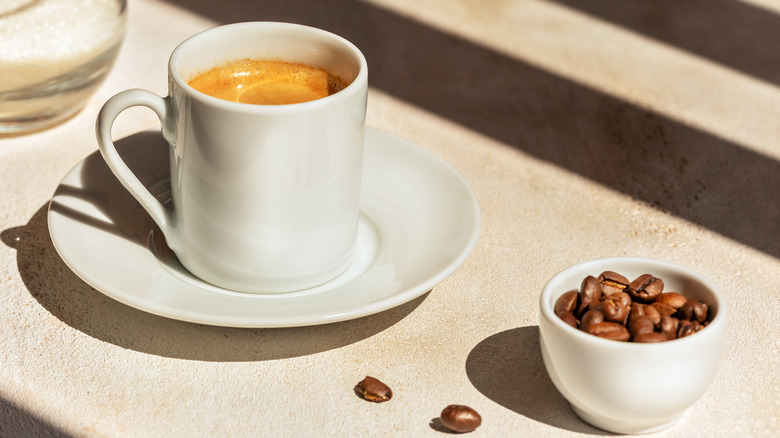4 Simple Ways To Tell If Your Coffee Has Gone Stale
Ah, dear coffee lover, you know the day can't start without the perfect cup of joe. And to get that ideal cup, it's crucial to keep your beans as fresh as possible. Proper storage plays a significant role in preserving their flavor and aroma, but sometimes, your coffee might not taste as good as it smells (or it actually might smell bad, too).
If that's the case, your coffee is likely stale. While coffee beans don't spoil, the flavor can fade over time, resulting in a less-than-satisfying cup of coffee. But how can you tell for sure if your beans have gone stale? From the appearance of the beans to the roast date, there are several factors to consider when assessing a coffee's freshness.
For example, freshly roasted beans will have a rich, complex aroma that is noticeably different from stale or old beans. Similarly, brewed coffee made from freshly roasted beans will have a bright, lively flavor with distinct notes typical of its variety (milky chocolate notes for blonde roasts or rich, caramel spice notes for a dark espresso roast, for example).
Over time, however, the natural oils in the beans can deteriorate. The flavors dissipate, and the aroma fades as coffee ages past its prime, resulting in a bland, uninspiring cup of coffee. Delve into the science of coffee freshness and explore the tell-tale signs that your coffee has lost its flavor.
Check the roast date and aroma
Checking the roast date on the bag is the first step in determining if your coffee has gone stale. Generally, whole coffee beans are at their prime within one to three weeks of opening the bag; Ground coffee preserves its freshness for about one to two weeks after opening.
However, storing your coffee correctly is important to ensure it's fresh for the longest time possible. The National Coffee Association recommends purchasing smaller batches of coffee you know you'll consume within the recommended "freshness timeframe" and storing them in a cool, dark location. Pour your beans into an opaque, air-tight container where they won't receive direct sunlight or heat.
But what if the roast date was recent, and the flavor still feels off? In this case, another way to identify stale coffee is to smell your coffee beans. Fresh coffee beans have an incredibly rich and fragrant aroma immediately noticeable when you grind them or even open the bag. Stale coffee beans have little to no aroma when you grind them, indicating they've lost their freshness. So if you open your bag of coffee and notice a marked lack of that intoxicating coffee smell, you might be better off getting new beans.
Check the beans for oil
If your coffee beans seem within their shelf life and still have that classic coffee aroma, you'll want to check them for oil. Start by looking at the surface, as a layer of oil on top of the beans can signify that they're relatively fresh.
Darker roasts will be oilier, which might make this difficult to test with sight alone if your go-to brew is a light roast. Moreover, both freshly roasted and stale coffee can have a slight sheen of oil, and different roasting methods can result in drier beans, so don't rely on this method alone. To really test for a stale stash of beans, you'll also need to get tactile.
When you touch freshly roasted coffee beans, whether whole or ground, you should feel slight oiliness or moisture. This oil is actually the flavor coming to the surface of the beans. Stale coffee won't feel that powdery or oily; it will feel dry and grainy, meaning that the oils have evaporated as the coffee has aged, and it's no longer at its freshest to brew.
Your coffee grinds shouldn't be visibly crumbly if you rub them between your fingers (that might indicate a grinding problem). However, if your ground coffee clumps together ever so slightly when rubbing it between your fingers, it's likely still fresh and ready for you to brew. Celebrate by using them to season a Negroni!


